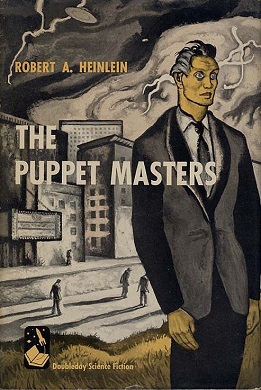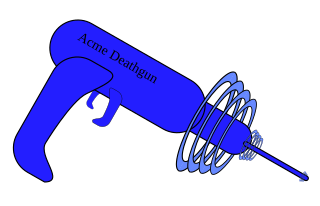Related Research Articles

Robert Anson Heinlein was an American science fiction author, aeronautical engineer, and naval officer. Sometimes called the "dean of science fiction writers", he was among the first to emphasize scientific accuracy in his fiction, and was thus a pioneer of the subgenre of hard science fiction. His published works, both fiction and non-fiction, express admiration for competence and emphasize the value of critical thinking. His plots often posed provocative situations which challenged conventional social mores. His work continues to have an influence on the science-fiction genre, and on modern culture more generally.

Science fiction is a genre of speculative fiction that typically deals with imaginative and futuristic concepts such as advanced science and technology, space exploration, time travel, parallel universes, and extraterrestrial life. It has been called the "literature of ideas", and often explores the potential consequences of scientific, social, and technological innovations.

Starship Troopers is a military science fiction novel by American writer Robert A. Heinlein. Written in a few weeks in reaction to the U.S. suspending nuclear tests, the story was first published as a two-part serial in The Magazine of Fantasy & Science Fiction as Starship Soldier, and published as a book by G. P. Putnam's Sons in December 1959.

The Puppet Masters is a 1951 science fiction novel by American writer Robert A. Heinlein, in which American secret agents battle parasitic invaders from outer space. It was originally serialized in Galaxy Science Fiction.

The alien invasion or space invasion is a common feature in science fiction stories and film, in which extraterrestrials invade the Earth either to exterminate and supplant human life, enslave it under an intense state, harvest people for food, steal the planet's resources, or destroy the planet altogether.
Science fiction is a film genre that uses speculative, fictional science-based depictions of phenomena that are not fully accepted by mainstream science, such as extraterrestrial lifeforms, alien worlds, extrasensory perception and time travel, along with futuristic elements such as spacecraft, robots, cyborgs, interstellar travel or other technologies. Science fiction films have often been used to focus on political or social issues, and to explore philosophical issues like the human condition.

Science fantasy is a mixed genre within the umbrella of speculative fiction which simultaneously draws upon or combines tropes and elements from both science fiction and fantasy. In a science fiction story, the world is presented as being scientifically possible, while a science fantasy world contains elements which violate the scientific laws of the real world. Nevertheless, the world of science fantasy is logical and often is supplied with science-like explanations of these violations.

Military science fiction is a subgenre of science fiction that features the use of science fiction technology, mainly weapons, for military purposes and usually principal characters who are members of a military organization involved in military activity, usually during a war; occurring sometimes in outer space or on a different planet or planets. It exists in literature, comics, film, and video games.

Strange and exotic weapons are a recurring feature in science fiction. In some cases, weapons first introduced in science fiction have been made a reality; other science-fiction weapons remain purely fictional, and are often beyond the realms of known physical possibility.

The Honorverse is a military science fiction book series, its two subseries, two prequel series, and anthologies created by David Weber and published by Baen Books. They are centered on the space navy career of the principal protagonist Honor Harrington. The books have made The New York Times Best Seller list.
Space warfare will be combat that will take place in outer space. The scope of space warfare therefore includes ground-to-space warfare, such as attacking satellites from the Earth; space-to-space warfare, such as satellites attacking satellites; and space-to-ground warfare, such as satellites attacking Earth-based targets. Space warfare in fiction is thus sub-genre and theme of science fiction, where it's portrayed with a range of realism and plausibility.
The exploration of politics in science fiction is arguably older than the identification of the genre. One of the earliest works of modern science fiction, H. G. Wells’ The Time Machine, is an extrapolation of the class structure of the United Kingdom of his time, an extreme form of social Darwinism; during tens of thousands of years, human beings have evolved into two different species based on their social class.
In both science fiction and utopia/dystopian fiction, authors have made frequent use of the age-old idea of a global state and, accordingly, of world government.
The first Golden Age of Science Fiction, often recognized in the United States as the period from 1938 to 1946, was an era during which the science fiction genre gained wide public attention and many classic science fiction stories were published. In the history of science fiction, the Golden Age follows the "pulp era" of the 1920s and 1930s, and precedes New Wave science fiction of the 1960s and 1970s. The 1950s are a transitional period in this scheme; however, Robert Silverberg, who came of age in the 1950s, saw that decade as the true Golden Age.

The history of science fiction films parallels that of the motion picture industry as a whole, although it took several decades before the genre was taken seriously. Since the 1960s, major science fiction films have succeeded in pulling in large audience shares, and films of this genre have become a regular staple of the film industry. Science fiction films have led the way in special effects technology, and have also been used as a vehicle for social commentary.

Space Western is a subgenre of science fiction that uses the themes and tropes of Westerns within science-fiction stories. Subtle influences may include exploration of new, lawless frontiers, while more overt influences may feature literal cowboys in outer space who use rayguns and ride robotic horses. Although initially popular, a strong backlash against perceived hack writing caused the genre to become a subtler influence until the 1980s, when it regained popularity. A further critical reappraisal occurred in the 2000s with Firefly and Cowboy Bebop.
The planetary systems of stars other than the Sun and the Solar System are a staple element in many works of the science fiction genre.
The following outline is provided as an overview of and topical guide to science fiction:

Space opera is a subgenre of science fiction that emphasizes and is part of the general thematic genre fictional space warfare with use of melodramatic adventure, interplanetary battles, chivalric romance, and risk-taking. Set mainly or entirely in outer space, it usually involves conflict between opponents possessing advanced abilities, futuristic weapons, and other sophisticated technology. The term has no relation to music, as in a traditional opera, but is instead a play on the terms "soap opera", a melodramatic television series, and "horse opera", which was coined during the 1930s to indicate a clichéd and formulaic Western movie. Space operas emerged in the 1930s and continue to be produced in literature, film, comics, television, and video games.
Marko Kloos is a German author of military science fiction and high fantasy. Born in Germany, Kloos lives and works in the United States.
References
- ↑ Andrew M. Butler (2005). "Philip K. Dick. Do Androids Dream of Electric Sheep?". In David Johnson (ed.). The Popular And The Canonical: Debating Twentieth-century Literature 1940–2000. Routledge (UK). p. 113. ISBN 0-415-35169-3.
- ↑ Eugene F. Mallove and Gregory L. Matloff (June 1989). The Starflight Handbook: A Pioneer's Guide to Interstellar Travel. Wiley. pp. 20. ISBN 0-471-61912-4.
- ↑ August 1939 Astounding Science-Fiction August 1939
- ↑ See (e.g.) E. E. "Doc" Smith (1951), Grey Lensman, chapter 23
- ↑ Uses the Death Star as an exercise in calculus
- ↑ A page on "How to Destroy the Earth."
- ↑ Star Wars Technical Commentaries on the Death Stars Archived November 28, 2006, at the Wayback Machine
- ↑ On Basilisk Station (1993)
- ↑ The Honor of the Queen (1993 ISBN 0-671-57864-2)
- ↑ The Short Victorious War (1994)
- ↑ Okuda, Michael & Denise (1997). The Star Trek Encyclopedia. New York City: Pocket Books. ISBN 0-671-53607-9. Images accessible at 2265-2370 Ranks. Spike's Star Trek Page Rank Chart.
- ↑ Swanson, Roy Arthur: “The True, the False, and the Truly False: Lucian’s Philosophical Science Fiction”, Science Fiction Studies, Vol. 3, No. 3 (Nov. 1976), pp. 227–239
- 1 2 Brian Stableford (2003-12-08). "Science fiction before the genre". In Edward James and Farah Mendlesohn (ed.). The Cambridge Companion to Science Fiction . Cambridge University Press. pp. 20–21. ISBN 0-521-01657-6.
- ↑ Antulio J. Echevarria II. "Challenging Transformation's Clichés" (PDF). Strategic Studies Institute, U.S. Army War College. Retrieved 2007-01-31.
- ↑ Darren Harris-Fain. "After the New Wave, 1970–1976". Understanding contemporary American science fiction: the age of maturity, 1970-2000. Univ of South Carolina Press. pp. 55–57. ISBN 1-57003-585-7.
- 1 2 3 Brooks Landon (2002). "From the Steam Man to the Stars". Science Fiction After 1900: From the Steam Man to the Stars. Routledge (UK). p. 70. ISBN 0-415-93888-0.
- ↑ H. Bruce Franklin (1990). War Stars: The Superweapon and the American Imagination. Oxford University Press. p. 200. ISBN 0-19-506692-8.
- ↑ Edison Conquest of Mars, Introduction Robert Godwin, page 6, Apoge 2005
- ↑ David Pringle (2000-01-30). "What is this thing called space opera?". In Gary Westfahl (ed.). Space and Beyond: The Frontier Theme in Science Fiction. Greenwood Press. pp. 40–41. ISBN 0-313-30846-2.
- ↑ Thomas D. Clareson (December 1992). Understanding Contemporary American Science Fiction: The Formative Period, (1926-1970). University of South Carolina Press. pp. 17–18. ISBN 0-87249-870-0.
- ↑ Jas Elsner, Joan-Pau Ribiés (1999). Voyages and Visions: Towards a Cultural History of Travel. Reaktion Books. p. 264. ISBN 1-86189-020-6.
- ↑ David G. Hartwell, Kathryn Cramer, The Space Opera Renaissance, Tor Books, ISBN 0-7653-0617-4. Introduction, p. 251
- ↑ "23 Best Military Science Fiction Books - The Best Sci Fi Books". 14 March 2015.
- ↑ Westfahl, Gary, ed. (2005). The Greenwood Encyclopedia of Science Fiction and Fantasy. Greenwood Publishing Group. p. 888. ISBN 9780313329524.
- 1 2 3 Green, Paul (2009). Encyclopedia of Weird Westerns. McFarland Publishing. ISBN 9780786458004.
- ↑ Lilly, Nathan E. (2009-11-30). "The Emancipation of Bat Durston". Strange Horizons . Archived from the original on 2014-03-14. Retrieved 2014-03-14.
- ↑ Abbott, Jon (2006). Irwin Allen Television Productions, 1964-1970: A Critical History of Voyage to the Bottom of the Sea, Lost in Space, The Time Tunnel and Land of the Giants. Jefferson, N.C: McFarland Publishing. p. 131. ISBN 0786486627.
- ↑ Williams, Owen (2014-07-24). "Peter Hyams Film By Film". Empire . Retrieved 2019-07-03.
- ↑ Steinberg, Don (2011-07-22). "Hollywood Frontiers: Outer Space and the Wild West". The Wall Street Journal . Retrieved 2014-03-15.